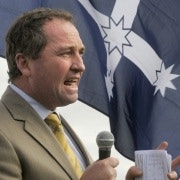An iron ore pitfall for Tony and Joe
Australia’s terms of trade, which rose a surprisingly strong 2.7 per cent in the March quarter, according to the national accounts issued on Wednesday, will come under renewed downward pressure in the September and December quarters. If that happens, it could be a rude awakening for a new government after the September 14 poll.
If it’s Opposition Leader Tony Abbott and shadow treasurer Joe Hockey in charge, they could find themselves on the back foot with a sluggish economy struggling to make the transition from the resource investment boom at a time when export returns are volatile. That’s because of the way iron ore prices, the biggest influence on the terms of trade, along with the value of the Aussie dollar, are set.
The terms of trade for this quarter could be a bit stronger than expected, with iron ore exports to China out of Port Hedland, the main export point, running at record levels last month. In the national accounts yesterday, the Bureau of Statistics reported that the 2.7 per cent improvement in the terms of trade in the quarter “was driven by increases in the price of metal ores and minerals, for which the largest component is iron ore. The seasonally adjusted implicit price deflator for Metal ores and minerals rose 9.5 per cent.”
And even though iron ore prices have fallen by around 20 per cent in this quarter so far (to nearly $US117), from the March quarter highs of more than $US148, the method of pricing the ore on a quarterly basis means this slide won’t have an impact on our terms of trade until the September quarter. Around half the annual volume of seaborne iron ore traded globally is priced on the basis of a quarterly index — that is based on global spot prices in the middle of the last month of the quarter — meaning current price levels, if sustained for the next fortnight, will be the price base for the September quarter’s contract.
It’s also for that reason that iron ore prices in March set the level for the current quarter (which ends on June 30).The value of the Aussie dollar is down around 8 per cent from the start of May and 10 per cent from the high of $US158 in February 2013, which will cushion the impact of the small fall. That means there could be another nice (but smaller) boost to our terms of trade in the June quarter national accounts (to be revealed in early September).
In 2012, the Reserve Bank pointed out:
“Market reports suggest that, in aggregate, monthly contracts and spot sales now account for more than half of all Australian iron ore exports, although this share varies somewhat across producers. The remainder of Australian iron ore exports are based on longer-term contracts, many of which are quarterly, with some large Japanese steel mills reportedly preferring this pricing arrangement. All of these changes in pricing arrangements mean that the average Australian export price of iron ore moves more closely with prices in the iron ore spot market than in the past.
“With iron ore currently accounting for around one-fifth of Australia’s exports, the greater use of shorter-term pricing has implications for the terms of trade. In general, the spot price for iron ore has tended to move in line with developments in Chinese industrial production and steel production, although disruptions to supply can also be important. Hence, changes in the outlook for Chinese growth and steel demand are likely to be reflected more quickly in the prices received by Australian iron ore producers than in the past.”
Reuters reported on Wednesday that iron ore exports to China from Port Hedland were a record 23.3 million tonnes in May, up 21 per cent from April and 34 per cent from May 2012. Chinese mills are clearly buying more ore as the spot price dips. If you believe the media stories in papers such as The Australian and Fairfax’s Sydney Morning Herald, The Age and The Australian Financial Review, the Chinese steel companies are in all sorts of problems, making dire warnings about their financial health, the strength of demand in China, etc, etc.
The usual moans and groans that seem to intensify around the middle of the last month of the quarter – that’s nothing to do with the way prices will be set for the September quarter, is it? But their purchases belie their moans. Don’t you wish the Australian media would connect the dots sometimes?
This article was first published on Crikey on June 6. Republished with permission.













